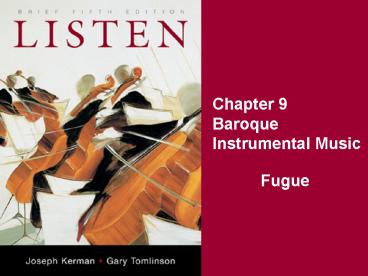Chapter 9 Baroque Instrumental Music PowerPoint PPT Presentation
1 / 17
Title: Chapter 9 Baroque Instrumental Music
1
Chapter 9Baroque Instrumental Music
- Fugue
2
Key Terms
- Fugue
- Fugue subject
- Expositions
- Subject entries
- Episodes
- Contrapunctus
- Free and learned fugues
- Fugato
- Fugal devices
- Countersubject
- Stretto
- Augmentation
- Diminution
- Inversion
3
Fugue
- The most significant, characteristic new form of
Baroque music - Rooted in systematic use of imitative polyphony
- Fugue polyphonic composition built on a single
principal theme (the subject) - For two or more instrumental lines (voices)
- Latin fuga running away
- Fugal voices imitatively chase each other
4
Fugal Exposition (1)
- First section of a fugue
- All voices (instrumental lines) take turns
presenting the subject in orderly fashion - Voices create cumulative effect
5
Fugal Exposition (2)
- 1st voice states subject all by itself
- Then 2nd voice states subject as 1st voice
continues with new material - Then 3rd voice states subject as 1st 2nd voices
continue with new material, etc. - Exposition ends when all voices state subject
6
Episodes and Subject Entries (1)
- After the Exposition, subject enters at intervals
separated by episodes - These later subject entries
- May occur in any voice
- Often come in different keys
7
Episodes and Subject Entries (2)
- Episodes contrast with subject entries
- They may be based on motives from subject
- They often use sequences to modulate
- Final subject entry is stated in tonic key
8
Subject Entries vs. Episodes
- Subject entries
- Fixedmust always be recognizable as the subject
- Stableremain in one key throughout each
statement - May occur in other keys in middle of fugue
- Episodes
- Freemay explore any motives from subject in any
order - Unstablemodulate from from one key to another
- Connect an entry in one key with another in a new
key
9
Fugues, Free and Learned
- Fugue can have multiple meanings
- Can refer to fugue as genre (a fugue)
- Uses exposition, subject entries, episodes
- Can refer to fugue as style or procedure
- Fugue as imitative section in a larger work
- A work in fugal style
- Free fugues
- Works using fugal style or procedures
- Learned fugues
- Full-scale, independent fugues
10
Free Fugue
- Often refers to fugal sections in a larger work
belonging to another genre - For example, perhaps in a a canzona, French
overture, or chorus - Fugal section often called a fugato
- Uses techniques of fugue, not its form
- Shorter than full-scale fugue
- Sometimes just the exposition
- May slip from polyphony (typical fugal texture)
to homophony and back
11
Learned Fugue
- Full-scale, independent fugue
- Fugue as genre
- Uses the features of fugal formexposition,
subject entries, episodes - Often written more for study teaching than for
public performance - Bachs Well-Tempered Clavier or Art of Fugue
- Shows off composers contrapuntal skill
- Uses sophisticated (learned) fugal devices
12
Fugal Devices
- Countersubject
- A melody designed to accompany the subject
throughout the fugue - Stretto
- Overlapping entranceswhen a subject entry jumps
in before the previous one is done - Augmentation diminution
- Making all note values longer or shorter
- Inversion
- Turning the subject upside down
13
Bach, The Art of Fugue
- Written at the end of Bachs life
- Unfinished at the time of his death
- A testament to his astonishing fugal skill
- Collection of twenty canons fugues
- All on the same subject!
- Most use all fugal devices listed above
- Unfinished final fugue is Bachs epitaph
- Theme No. 4 spells B-A-C-H
- In German music B B-flat H B-natural
14
Bach, Contrapunctus 4 (1)
- Fugue in four voices
- Voices enter from high to low in exposition
15
Bach, Contrapunctus 4 (2)
- Lengthy episodes based on subjects final motive
a cuckoo figure
16
Bach, Contrapunctus 4 (3)
- Later subject entries clustered together
- Almost like secondary expositions
- Voices often enter in different order
- Fugal devices usedstretto near the end
- At times uses expanded version of subject
17
Conclusions
- Exposition the most characteristic part
- Easy to follow owing to cumulative nature
- Harder to follow later entries episodes
- Continuous polyphonic flow with subtle contrasts,
not sharp ones - Good learned fugues build episodes around motives
from the subject - Systematic treatment of subject typical of
Baroque compositional control - Fugue the most scientific Baroque genre

